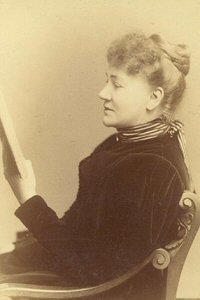Florence Marryat facts for kids
Florence Marryat (born July 9, 1833 – died October 27, 1899) was a British author and actress. She was the daughter of the well-known author Captain Frederick Marryat. Florence became famous for her exciting novels and her interest in spiritualism. This was a belief in communicating with spirits.
Some of her popular books include Love’s Conflict (1865) and The Blood of the Vampire (1897). She wrote about 70 books in total. She also wrote articles for newspapers and magazines. Besides writing, Florence had a performing career from 1876 to 1890. She acted in plays, sang in comic operas, and gave lectures. In the 1890s, she even ran a school for journalism.
Contents
Early Life
Florence Marryat was born in Brighton, England, in 1833. Her father was Captain Frederick Marryat, a naval officer and author. Her mother was Catherine Shairp. Florence's parents separated when she was young. She spent her childhood living with both parents and was taught at home.
In 1854, just before her 21st birthday, she married Thomas Ross Church. He was an officer in the British Army in India. They traveled a lot in India for seven years. In 1860, Florence returned to England with her children. Her husband visited only sometimes. She had eight children with Church. Three of them were born in India.
Writing and Performing Career
Florence Marryat wrote her first novel, Love’s Conflict, in 1865. She wrote it to keep her mind busy while her young children were sick. The book was quite successful. She quickly followed it with other novels like Too Good for Him and Woman Against Woman. These early books were popular because people loved exciting stories. She continued writing novels for 35 years. In 1872, she wrote a book about her father's life. From 1872 to 1876, she also edited a monthly magazine called London Society.
By the mid-1870s, Florence was a successful author around the world. She worked with George Grossmith on a funny touring show called Entre Nous. This show had piano sketches and short plays. In 1879, Florence and her husband divorced. Later that year, she married Colonel Francis Lean. However, they divorced just one year later.
In 1881, at age 48, Florence returned to the stage. She acted in a play she wrote, based on her novel Her World Against a Lie. The next year, she joined a D'Oyly Carte Opera Company tour. She played Lady Jane in Gilbert and Sullivan's Patience. She also acted in other plays. In 1886, Florence wrote a fun book about her travels in the United States. It was called Tom Tiddler's Ground. She later performed her own one-woman show. She also gave lectures and entertained audiences. She kept performing until 1890.
Later Life and Legacy
Florence Marryat became involved with the Society of Authors. This group was founded in 1884 to support writers. She also started breeding bulldogs and terriers. In her last 14 years, she had a close companion, Herbert McPherson. He later inherited part of her property. During the 1890s, she managed a school for journalism and writing.
Florence continued writing until the end of her life. Some of her most famous books were about spiritualism. These included There is No Death (1891) and The Spirit World (1894). Her writings on spiritualism influenced Gerald Gardner, who later founded Wicca.
Florence Marryat died in 1899 from diabetes and pneumonia. She is buried in Kensal Green Cemetery in London.
Works and Public Opinion
Florence Marryat published 68 novels. She also wrote non-fiction books, like the one about her father's life. She wrote many newspaper and magazine articles, short stories, and plays.
People found Florence's books easy to read and exciting. Reviewers noted her "graphic, nervous, vital" writing style. However, some critics called her work "cynical" and "third-rate." They felt her plots relied too much on common legal problems. Despite what critics said, her novels stayed very popular with the public.
Novels
|
Short Story Collections
Children’s Stories
Collaborations
Plays
Memoirs
Spiritualism Books
|


